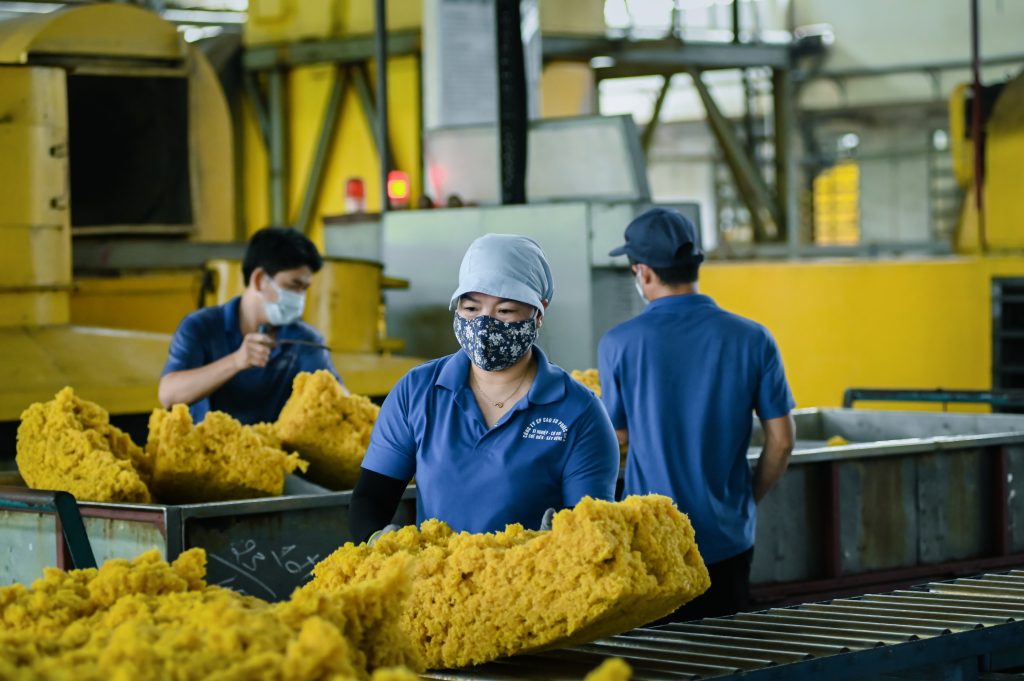Source: tapchicaosu.vn

Processing natural rubber at Phuoc Hoa Rubber
Natural rubber is known for its elasticity, toughness, and resistance to water and abrasion. Its versatility makes rubber an important component in various industries, including automotive, construction, chemicals, aerospace, food, textiles and footwear, pharmaceuticals, and petroleum.
Demand for natural rubber continues to rise due to its affordable price, lightweight properties, and suitability for a wide range of applications. From insulation to automobile and aircraft tires, natural rubber remains indispensable in various sectors, driving natural rubber consumption to reach an estimated value of US$30,914 million by the end of 2033.
PV (according to www.fmiblog.com)
SMX successfully tests traceability
SMX, a company that digitizes physical objects for the circular economy, has announced the successful completion of tagging 21 tonnes of natural rubber sourced from Latin America, tracking its journey from tree to tire.
The program involves marking rubber on trees in Latin America, followed by processing and manufacturing within the region. Farmers apply the SMX mark to latex cups during harvest before transporting them to a production center, where 42 tons of latex are converted into 21 tons of natural rubber. The rubber bales are then sent to tire manufacturing facilities to be used to make tires for cars, trucks, and commercial vehicles.
The tires then underwent an assessment process, and SMX said it had a 100% success rate in verifying the origin of the natural rubber. SMX said this demonstrated its verification technology, which shows full traceability and data integrity throughout the entire supply chain, from tree to tire.
“We are pleased to be able to demonstrate the value of SMX in providing end-to-end supply chain authentication and traceability from tree to tire,” the company said. “We look forward to further developing our solutions in the global supply chain for the automotive industry. This is the third solution for natural rubber provided by SMX, including bicycle tires, engine frames and internals – and now for car and truck tires. We continue to work to support the industry in standardizing reporting on natural rubber sourcing.”
Q.A (according to tiretechnologyinternational.com)
The world may have a shortage of 800 thousand tons of rubber per year in 2024 – 2025
This supply-demand gap comes from global natural rubber consumption which can maintain a growth rate of 4-6% per year, thanks to the recovery of the global automobile and tire manufacturing industry, especially in the Chinese market.
In the latest report, the Import-Export Department (Ministry of Industry and Trade) stated that in the period of 2024-2025, the global market may have a shortage of about 600-800 thousand tons per year.
This supply-demand gap is due to the fact that global natural rubber consumption is likely to maintain a growth rate of 4-6% per year, thanks to the recovery of the global automobile and tire manufacturing industry, especially in the Chinese market. The production and export of tires in Thailand and India are also growing positively and are expected to continue to increase in 2024.
However, the global supply of natural rubber is expected to grow by an average of only 1-3% per year in the period 2024-2025. Rubber planting areas in Thailand and Indonesia have continuously decreased due to diseases on rubber trees and the trend of switching to other industrial crops with higher economic efficiency.
Rubber yields have also declined in recent years due to disease and extreme weather. In particular, 2024 is expected to be a tough year for rubber trees as the El Nino and La Nina transitions, causing many fluctuations in the peak tapping season in Southeast Asia.
The La Nina phenomenon that is likely to occur in the second half of 2024 will continue to cause concerns for Thai and global supply, as this is the peak season for rubber tapping, after the end of the tapping and leaf-changing period in the first half of the year. In the first two months of 2024, Thailand’s rubber output reached 871 thousand tons, down 0.4% compared to the same period in 2023.
